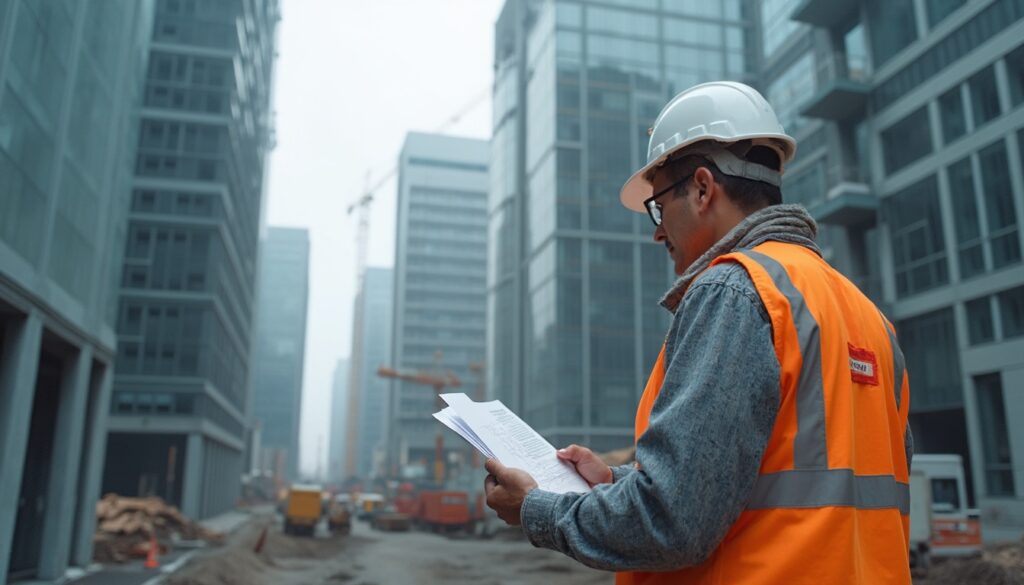Defect report according to VOB/B §13 No. 5: This lays the foundation for successful project completions
What exactly is a defect report after acceptance according to VOB/B §13 No. 5?
To be honest, legal writings often sound dry. But a defect report after acceptance VOB/B §13 No. 5 is much more than just a piece of paper. Think of it as a formal notice to your contractor, informing them of defects that have arisen after the construction acceptance and requesting their rectification. This important document, the defect report after acceptance VOB/B §13 No. 5, is not just information but a vital legal tool that paves the way for your warranty claims. The correct formulation and delivery of such a defect report after acceptance VOB/B §13 No. 5 is priceless here because errors can quickly lead to the loss of your rights. In everyday construction, this means: Every deviation from what was agreed upon or the recognized standards must be documented meticulously. The challenge often lies in structuring and creating a legally secure format from the numerous observations on the construction site, as required for a defect report after acceptance VOB/B §13 No. 5 defect report. This is exactly where we at Valoon GmbH come in with our digital solutions such as our defect management app, to simplify this process and optimize data collection.
- Formal notice: Informs the contractor about defects that occurred after acceptance.
- Legal tool: Paves the way for warranty claims and calls for defect rectification.
- Crucial importance: Secures your rights to rectification, reduction, or damages.
- Documentation obligation: Requires accurate recording of deviations from the agreed or the technical standards.
Why is the defect report after acceptance so crucial?
It cannot be emphasized enough: A correct defect report after acceptance VOB/B §13 No. 5 is incredibly important. It is your first and foremost step to secure your warranty claims according to § 13 VOB/B . Without a properly formatted and timely defect report after acceptance VOB/B §13 No. 5 , you as the client risk losing your rights to rectification, reduction, or even damages. It becomes particularly tricky due to the reversal of the burden of proof after acceptance: now you, as the client, must prove that the defect was already present at acceptance or arose from the contractor’s work. A detailed and well-documented defect report after acceptance VOB/B §13 No. 5 is your strongest argument here. For contractors, a clear notice means they can quickly respond and fend off unjustified claims. An efficient defect tracking via construction app helps both parties keep track and avoid misunderstandings from the outset.
What to expect in this article: A comprehensive view for builders and contractors
With this article, we aim to provide you with an understandable overview of the requirements and potential pitfalls of the defect report after acceptance VOB/B §13 No. 5 . We will jointly examine the legal principles, explain what needs to be considered formally and substantively in a defect report after acceptance VOB/B §13 No. 5 , and outline what rights and obligations arise for both parties. Our goal is to equip you with the tools to avoid mistakes and effectively enforce your claims – or to behave correctly as a contractor. A good understanding of the process surrounding the defect report after acceptance VOB/B §13 No. 5 is a vital component for successful defect management and helps tremendously in reducing conflicts. At Valoon GmbH, we have made it our mission to simplify and clarify such complex processes with innovative software solutions, enabling you to focus entirely on your core business. Discover how, with our experience and tools, you can make your construction projects more efficient.VOB/B §13: Mastering legal hurdles with defects – Acceptance as a key moment
VOB/B or BGB – What applies now?
A fundamental question that often stands at the beginning: When it comes to defect claims, does the Award and Contract Regulations for Construction Services Part B (VOB/B) or the Civil Code (BGB) come into play? This is particularly important for the defect report after acceptance VOB/B §13 No. 5. Important to know: The VOB/B is not self-explanatory; it must be expressly agreed upon between you and your contractual partner , especially regarding the validity of a defect report after acceptance VOB/B §13 No. 5 . If this has not happened, the rules of the contract law in the BGB apply. Especially for construction contracts, particularly with public clients or between construction companies, the VOB/B is common practice and often the better choice because it offers specific rules for construction services – like our §13 VOB/B for defect claims. You should definitely know which law applies because deadlines, formal requirements, and the legal implications of a defect report after acceptance VOB/B §13 No. 5 differ significantly. A wrong assumption here can have really unpleasant consequences.
A closer look at §13 VOB/B: What lies behind warranty and defect claims?
§13 VOB/B is essentially the focal point for defect claims when a VOB/B contract is in place. It precisely defines what the contractor is liable for (warranty) and when a defect actually exists. For our defect report after acceptance VOB/B §13 No. 5 the fifth paragraph of this regulation is particularly important. The correct application of §13 VOB/B is crucial for the effectiveness of your defect report after acceptance VOB/B §13 No. 5. It states that you, as the client, must formally notify defects that arise after acceptance and before the expiration of the limitation period for defect claims, through a defect report after acceptance VOB/B §13 No. 5 written notification. An important point after acceptance is the reversal of the burden of proof: From now on, you as the client must prove that the defect arose from a non-contractual performance by the contractor and was already present at the handover of responsibility (transfer of risk). This is a core aspect in creating a defect report after acceptance VOB/B §13 No. 5. A comprehensive documentation, preferably supported by a digital defect management, is essential for you as the client to substantiate your claims.
What does ‘acceptance’ actually mean in legal terms?
Acceptance is a really important moment in the construction contract – a true turning point. With the acceptance according to §12 VOB/B, you, as the client, basically say: ‘Yes, the performance is as we agreed.’ This has significant consequences: The payment becomes due, the clock for the limitation of defect claims starts ticking, and the risk for the construction project shifts to you. And, as previously mentioned, the burden of proof for defects is reversed. Therefore, our tip: Check everything very carefully before acceptance and preferably use a checklist for construction acceptance. If you discover defects during acceptance, they must be documented in the acceptance protocol to safeguard your rights, which can also affect the later necessity of a defect report after acceptance VOB/B §13 No. 5 adjustment.
Why the acceptance protocol is so important
The acceptance protocol is one of the most important documents in the entire construction process and also plays a significant role for the defect report after acceptance VOB/B §13 No. 5 . In it, you document how the construction project looked at the time of acceptance, what defects may have already been noted, and whether you, as the client, have specific reservations. A detailed acceptance protocol according to VOB, signed by both parties, is a strong piece of evidence, even in the context of a later defect report after acceptance VOB/B §13 No. 5. Caution: If defects are noticed during acceptance but are not documented in the protocol and you also do not express a reservation, you may lose your claims for this reason (§ 640 para. 3 BGB, § 12 para. 5 No. 1 VOB/B). The digital collection and management of such protocols, as we offer at Valoon GmbH with our software, helps you capture everything completely and understandably, which is advantageous for any potential defect report after acceptance VOB/B §13 No. 5 claims.
And what if acceptance is refused?
As a client, you can refuse acceptance if there are serious defects present (§12 para. 3 VOB/B). A defect is considered serious when the construction cannot be properly used as a result or if essential promised characteristics are missing. However, for minor, insignificant defects, you cannot refuse acceptance – these should be documented in the protocol and must be rectified later under warranty. If you rightly refuse acceptance, the typical consequences of acceptance (payment due, limitation begins, risk is transferred, burden of proof is reversed) do not initially occur. The contractor must then rectify the defects and ensure that everything is ready for acceptance. It is important to document the reasons for your refusal carefully, which could serve as the basis for a later defect report after acceptance VOB/B §13 No. 5 claim if not all defects are resolved.Defect report VOB/B §13 No. 5: This is how it must look – form, content, and tips for watertight claims
The form must be right: What you must consider for the defect report
For your defect report after acceptance VOB/B §13 No. 5 to really count, a few formal rules must be followed. According to §13 para. 5 No. 1 VOB/B, the defect report after acceptance VOB/B §13 No. 5 must be in writing. Even though emails are the norm today, caution is advised here: The district court of Frankfurt has ruled, for instance, that a regular email without a qualified electronic signature does not count as ‘written.’ If you want to be completely sure, send your defect report after acceptance VOB/B §13 No. 5 per registered letter with return receipt. This way, you can later prove beyond doubt that it has arrived at the contractor. This strict rule illustrates how important it is to handle communication on construction sites carefully. Digital helpers like a digital defect recording for construction can certainly assist you in preparing and documenting your defect report after acceptance VOB/B §13 No. 5 , but the final dispatch may sometimes need to take the traditional route.
- Adhere to written form: Die defect report after acceptance VOB/B §13 No. 5 must be carried out in writing according to VOB/B §13 para. 5 No. 1.
- Choose secure delivery: Sending by registered letter with return receipt is recommended to prove delivery.
- Specify the correct recipient: The notice must be addressed to the contractor named in the construction contract.
- Describe the defect precisely: A detailed representation of the defect (location, type, impact) is essential, ideally with photos.
- Set an appropriate deadline: A realistic deadline for rectifying the defect with a specific end date must be established.
The right recipient: A small detail, big impact
Not only does written form matter, but also the correct address is an often-overlooked point, but super important. The defect report after acceptance VOB/B §13 No. 5 ist ein Punkt, der oft übersehen wird, aber super wichtig ist. Die defect report after acceptance VOB/B §13 No. 5 must of course go to your contractual partner, meaning the contractor named in the original construction contract. If it’s a company, ensure that the notification goes to the official business address and perhaps even to a person named in the contract as authorized to receive it. Errors here can mean that the defect report after acceptance VOB/B §13 No. 5 is considered undelivered, and you may miss important deadlines. So: It’s better to take another look at the contract documents! A central project database, like the one we offer at Valoon GmbH, can help you always have the correct and up-to-date address details of all project participants ready.
What should be included? The content of a defect notification
For your defect report after acceptance VOB/B §13 No. 5 must also really have an effect; it needs to contain certain information. Only then can the contractor examine and remedy the defect. The most important thing in a defect report after acceptance VOB/B §13 No. 5 is a detailed description of the defect: Where exactly is the defect (e.g., which component, which room, where exactly in the room)? What does it look like or how does it manifest (e.g., cracks, damp spots, something is not working)? Photos and excerpts from plans are invaluable here! Describe the impact of the defect, but do not speculate about the cause – that is the contractor’s task. Additionally, you must set a reasonable deadline for defect rectification . What is considered ‘reasonable’ depends on the nature and extent of the defect. And of course, a clear request to rectify the defect should be included. The question ‘How should a defect notification according to VOB look like?’ can therefore best be answered with ‘detailed!’, especially when it comes to a defect report after acceptance VOB/B §13 No. 5 .
Describing the defect precisely: Clarity creates relief
A precise defect description is truly essential for a successful defect report after acceptance VOB/B §13 No. 5. Vague statements like ‘window leaking’ help no one. It’s better to say: ‘In the living room, the left window (according to plan position 3.2) is leaking at the bottom seal. When it rains, water comes in, and the windowsill and the wall next to it are visibly damp over an area of about 20×30 cm.’ Photos and exact location details are indispensable here. The goal is to describe the defect so clearly that the contractor can immediately locate it and check if they are responsible. If the description is too vague, it could render the whole defect report after acceptance VOB/B §13 No. 5 invalid. Tools for digital defect documentation, such as PlanRadar integrations, or our own Valoon platform help you ensure the necessary accuracy and traceability for your defect report after acceptance VOB/B §13 No. 5 .
Setting the right deadline: Not too short, not too long
One very important point in your defect report after acceptance VOB/B §13 No. 5 is that you set a reasonable deadline for defect rectification. What ‘reasonable’ means always depends on the specific case – especially on the nature and size of the defect and how complex the repair is. A deadline that is too short can invalidate your defect report after acceptance VOB/B §13 No. 5 , while a deadline that is too long only unnecessarily delays the solution. Often two weeks is a good guideline, but with more complicated defects, it can take longer. It’s best to specify a concrete date (e.g., ‘by TT.MM.YYYY’). If the contractor simply lets the deadline pass, you as the client can initiate further steps, such as commissioning the repair yourself. It’s wise to already hint in the defect report after acceptance VOB/B §13 No. 5 what happens when the deadline expires to make it clear that you are serious.
Checklist for a solid defect notification
For your defect report after acceptance VOB/B §13 No. 5 to ensure it is really valid and legally effective, you should definitely keep these points in mind:
- Describe defects very precisely: Explain each defect in as much detail as possible, with location and effects (e.g., ‘crack in tile X in the upstairs bathroom next to the door’). Photos or excerpts from plans are excellent! Avoid vague formulations and do not guess about the cause. This is central for every defect report after acceptance VOB/B §13 No. 5.
- In writing and with proof: Preferably by letter and as registered mail with acknowledgment of receipt. This way, you can be sure and prove that the notification has arrived – this is often not so clear with a simple email.
- Set a realistic deadline: Give the contractor a fair deadline for rectifying the defect so that they have enough time for examination and action. Specify a clear end date.
Received a defect notification according to VOB/B? This is what contractors need to know now: Obligations, rights & costs in sight
Obligation to respond: What if the contractor does not respond?
If you as a contractor receive a defect report after acceptance VOB/B §13 No. 5 , it’s your turn: You must respond within the set reasonable timeframe. This does not necessarily mean that you have to rectify the defect immediately, but at least provide feedback on the received defect report after acceptance VOB/B §13 No. 5 is required. If you simply ignore the defect report after acceptance VOB/B §13 No. 5 and let the deadline pass, you will be in default. This, in turn, gives the client further legal options, for example, they may threaten and carry out a substitute performance – at your expense. No response is therefore quite risky for you as a contractor and can be costly. A quick and professional communication, best supported by a system for change order and defect management according to VOB/B, is key to smoothing over the situation, especially after receiving a defect report after acceptance VOB/B §13 No. 5.
Contractor’s duty to investigate: Get to the bottom of the causes and clarify responsibility
After you have received a defect report after acceptance VOB/B §13 No. 5 , you not only have the right but also the obligation to examine the reported defect. This involves determining the cause of the defect and clarifying who is responsible – points that are often hinted at in the defect report after acceptance VOB/B §13 No. 5 . Is the defect really due to your work, or are there other reasons (e.g., faulty preliminary work by other companies, incorrect use by the client, normal wear and tear)? Careful documentation during the construction phase, for example, with a digital construction diary, is invaluable for you as a contractor to fend off unjustified claims from a defect report after acceptance VOB/B §13 No. 5 . You should promptly inform the client of the results of your examination, referring to the defect report after acceptance VOB/B §13 No. 5.
Rejecting defect rectification: When is that okay?
As a contractor, you can reject the rectification of a defect reported with a defect report after acceptance VOB/B §13 No. 5 under certain circumstances. This is the case, for example, if the defect rectification is technically not possible at all. Another reason could be that the costs of defect rectification are disproportionately high (§13 Abs. 6 VOB/B). This is the case when the effort for the repair is not in a reasonable proportion to the result and instead, a price reduction can be offered to the client. And of course, you can reject responsibility for the defect if you can prove that it was not caused by your work. In any case, you must justify your rejection well and inform the client in writing, in response to the defect report after acceptance VOB/B §13 No. 5. Open communication is key here.
Cost notification and offer for defect rectification: Ensuring transparency and security
If you are responsible for the defect and want to rectify it, you should communicate this to the client, ideally as confirmation of the defect report after acceptance VOB/B §13 No. 5. In more complicated cases or if the scope is unclear, it might be wise to create a cost notification or a detailed offer for defect rectification before starting work – even if you are technically responsible for the costs as part of the warranty. This creates clarity. If you can rectify the defect but dispute responsibility for it (e.g., because you suspect another cause), you can offer to rectify the defect for payment and simultaneously submit a cost notification. This way, you protect yourself from having to bear the costs if it later turns out that you were not actually responsible. A clear Defect clearance notification according to VOB template after successful rectification then completes the process neatly.Defects still present? These rights you have as a client according to VOB/B §13 No. 5
The extension of deadlines: A last chance for the contractor
If the contractor does not respond to your original defect report after acceptance VOB/B §13 No. 5 or fails to rectify the defect within the set deadline, you as the client should grant them a extension of deadline . This extension refers to the original defect report after acceptance VOB/B §13 No. 5 and must also be reasonable, giving the contractor a last opportunity to fulfill their contractual obligations. Setting an extension is often a prerequisite for you as a client to assert further rights such as self-performance or withdrawal from the contract, which arise from the unanswered defect report after acceptance VOB/B §13 No. 5 . In the letter setting the extension, you should clearly indicate what consequences will follow if this deadline also passes without action. Careful documentation of all communication steps, best supported digitally by a defect tracking app for construction, is immensely important here to strengthen your position in case of dispute.
- Set an extension of deadline: Give the contractor a final, reasonable deadline for defect rectification.
- Carry out self-performance: Commission another company after the unsuccessful expiration of the deadline and demand costs from the original contractor.
- Reduce payment: Request a reduction in payment if rectification is not possible or unreasonable.
- Claim damages: Assert claims for consequential damages caused by the defect.
Self-performance: Taking defect rectification into your own hands
If the contractor also lets the extension pass without rectifying the defect from the defect report after acceptance VOB/B §13 No. 5 , you as the client have the right to self-performance. The basis for this is the previous defect report after acceptance VOB/B §13 No. 5. This means you can rectify the defect yourself or commission another company to do so and reclaim the necessary costs from the original contractor. It is important that the costs for the self-performance must be reasonable. Our tip: Before commissioning a third party, obtain several competitive offers to be able to prove the reasonableness. You can even request an advance from the contractor for the expected costs of defect rectification. Accurate documentation of the defects and the work performed is essential for later reimbursement of costs.
Prerequisites for self-performance – What must be observed?
Self-performance after a defect report after acceptance VOB/B §13 No. 5 is tied to clear conditions. First, of course, a defect must be present for which the contractor is responsible, and which has been correctly reported using the defect report after acceptance VOB/B §13 No. 5 notification. You as the client must have reported the defect correctly and on time and set the contractor a reasonable deadline for remedying the defect. This deadline must have expired unsuccessfully. There are exceptions, for example, in cases of imminent danger or if the contractor seriously and definitively refuses the repair – then a deadline setting in the context of the defect report after acceptance VOB/B §13 No. 5 may sometimes be omitted. The adherence to these requirements is truly crucial, as an unauthorized self-performance can lead to you being stuck with the costs. A professional defect management app can help you document the entire process in a legally secure manner.
Reduction of the contract price: A financial alternative
If a defect remedy by the contractor after a defect report after acceptance VOB/B §13 No. 5 is not possible, is disproportionately expensive, or is refused by the contractor, you as the client can request a reduction of the contract price (§13 para. 6 VOB/B). This is an alternative when the defect report after acceptance VOB/B §13 No. 5 does not lead to remediation. The amount of the reduction depends on how much the work is worth less due to the defect. It should reflect the amount by which the contract price would have been lower from the beginning had the defect been known. Calculating the reduction can be tricky and often requires an expert’s judgment. A reduction is also an option if you have no longer any interest in remedying the defect, but it restricts the value or usability of the service.
Damages: If the defect causes further damages
If a defect that you have raised within a defect report after acceptance VOB/B §13 No. 5 causes further damages (so-called consequential damages), you as the client can claim damages from the contractor under certain conditions (§13 para. 7 VOB/B). This usually presupposes a fault on the part of the contractor, meaning that they intentionally or negligently caused the defect. Damages can be claimed, for example, for repair costs on other components, loss of use, or expert costs. The claim for damages exists in addition to the claim for defect remedy or reduction that arises from the defect report after acceptance VOB/B §13 No. 5 The exact documentation of the defect and the resulting consequential damages is absolutely critical for enforcing claims for damages.After the defect notification VOB/B §13 No. 5: How to secure evidence and resolve conflicts smartly
The power of documentation: Photos, protocols, and expert opinions
A comprehensive and accurate documentation is invaluable throughout the construction process, but especially in connection with a defect report after acceptance VOB/B §13 No. 5. Photos and videos, that clearly show the defect, detailed protocols of findings and discussions regarding the defect report after acceptance VOB/B §13 No. 5 , as well as possibly initial assessments from professionals can make a decisive difference in case of disputes. This documentation helps not only to strengthen your own position regarding the defect report after acceptance VOB/B §13 No. 5 , but also to avoid misunderstandings and facilitate a factual discussion. We at Valoon GmbH know from experience how important simple and structured data collection is. Our software solutions, like the digital defect management, are specifically designed to support you in building a solid chain of evidence by, for example, directly associating all communication with the projects and securely storing it.
The judicial evidence preservation procedure: An option in case of disputes
If clients and contractors simply cannot agree on whether a defect exists, who caused it, or who is responsible, a defect report after acceptance VOB/B §13 No. 5 judicial evidence preservation procedure can be a good option to clarify the points mentioned in the This procedure serves to determine the condition of an item or the cause of a defect by an expert appointed by the court before anything is changed (e.g., through repair attempts). Although the outcome of this procedure is not directly binding for a later court procedure, the expert’s opinion often carries significant weight and can be a solid basis for an out-of-court settlement or a court decision. It is an important means to defect report after acceptance VOB/B §13 No. 5 genannten Punkte zu klären. Dieses Verfahren dient dazu, den Zustand einer Sache oder die Ursache eines Mangels durch einen vom Gericht bestellten Sachverständigen feststellen zu lassen, bevor etwas verändert wird (z.B. durch Reparaturversuche). Das Ergebnis dieses Verfahrens ist zwar nicht direkt bindend für ein späteres Gerichtsverfahren, aber das Gutachten des Sachverständigen hat oft großes Gewicht und kann eine gute Basis für eine außergerichtliche Einigung oder eine gerichtliche Entscheidung sein. Es ist ein wichtiges Mittel, um establish objective facts, when the positions regarding a defect report after acceptance VOB/B §13 No. 5 are hardened.
Alternative dispute resolution: Mediation and arbitration instead of court
Not every dispute surrounding a defect report after acceptance VOB/B §13 No. 5 has to end up in court. Alternative methods of dispute resolution like mediation or arbitration can often provide quicker, cheaper, and less nerve-wracking solutions for conflicts arising from a defect report after acceptance VOB/B §13 No. 5 . In a mediation, a neutral third party (the mediator) tries to lead the parties toward a joint solution. An arbitration is similar to a court procedure, but takes place before a private arbitration court and is often confidential. Many construction contracts nowadays already contain clauses for alternative dispute resolution. Such procedures can help maintain the business relationship between the parties despite disagreements. A clean defect release report according to VOB can then formally conclude the process after a successful agreement and remedy. The role of the expert: Objective opinion from a professional
Die Rolle des Sachverständigen: Objektive Meinung vom Profi
In many cases involving the assessment of construction defects after a defect report after acceptance VOB/B §13 No. 5 , the expertise of an independent expert is required. A construction expert can objectively examine the reported defect, which is the subject of the defect report after acceptance VOB/B §13 No. 5 , find its cause, assess the extent, and suggest proposals for a proper remedy. Their report can serve as a basis for negotiations between the parties or be used as important evidence in the event of a legal dispute. The selection of a qualified and impartial expert is, of course, crucial. The costs of a private report are initially borne by the one who commissions it, but they can be claimed as part of the damages in a successful case. Even beforehand, utilizing a, seine Ursache finden, den Umfang bewerten und Vorschläge für eine fachgerechte Beseitigung machen. Sein Gutachten kann als Grundlage für Verhandlungen zwischen den Parteien dienen oder im Falle einer gerichtlichen Auseinandersetzung als wichtiges Beweismittel herangezogen werden. Die Auswahl eines qualifizierten und unparteiischen Sachverständigen ist dabei natürlich entscheidend. Die Kosten für ein Privatgutachten trägt erstmal derjenige, der es in Auftrag gibt, sie können aber im Erfolgsfall als Teil des Schadensersatzes geltend gemacht werden. Schon im Vorfeld kann die Nutzung einer checklist for construction acceptance can help minimize potential points of dispute that could later lead to a defect report after acceptance VOB/B §13 No. 5 .
You see, the proper handling of a defect report after acceptance VOB/B §13 No. 5 is truly a key component in minimizing risks and securing the quality of your construction projects. With the right knowledge and the right tools at your side, you can ensure that defects reported via defect report after acceptance VOB/B §13 No. 5 are handled professionally and that your projects are successfully completed. We at Valoon GmbH are happy to assist you in optimizing your communication and project management processes. Perhaps now is the right time to digitalize and simplify your workflows? Just reach out to us! We are happy to provide you with individual advice and show you how we can take your project documentation and defect management to the next level together.
What is a defect notification after acceptance according to VOB/B §13 No. 5?
A defect report after acceptance VOB/B §13 No. 5 is a formal, written notification to the contractor. It informs them about defects discovered after the construction acceptance and requests them to remedy them. It is the foundation of your warranty claims.
Why is the correct defect notification after acceptance so important?
A timely and properly formatted defect notification is crucial for securing your rights to rectification, reduction, or damages according to §13 VOB/B. Mistakes can lead to loss of these claims, especially since after acceptance the burden of proof lies with the client .
What information must a defect notification according to VOB/B §13 No. 5 necessarily contain?
A valid defect notification requires: detailed information about the construction project, a precise description of each defect (location, type, impact, ideally with photos), a clear request for defect remediation and a reasonable deadline with a specific end date.
Does the defect notification always have to be sent in writing via registered mail?
Yes, §13 para. 5 No. 1 VOB/B requires the written form. Sending via registered mail with return receipt is strongly recommended, to unequivocally prove receipt by the contractor . A simple email is often not sufficient. zu können. Eine einfache E-Mail reicht oft nicht aus.
What happens if the contractor does not respond to the defect notification?
If the contractor does not respond within the specified time, they are in default. You should set them a grace period. If this period also passes, you can have the defects remedied yourself (self-performance) and claim the costs from the contractor or initiate further legal steps. und die Kosten vom Auftragnehmer fordern oder weitere rechtliche Schritte einleiten.
How can software like Valoon assist me in creating a defect notification?
Software solutions like Valoon simplify the digital documentation of defects directly on-site, e.g., via messenger. They help to collect and document all information in a structured manner, including photos and make the communication traceable, which greatly facilitates the creation of a legally secure defect notification.
.
What is the difference between a defect notification according to VOB/B and BGB? The VOB/B must be expressly agreed upon , otherwise the BGB applies. §13 VOB/B containsspecific regulations for construction services
, e.g., regarding the written form of the defect notification and deadlines. The reversal of the burden of proof after acceptance is a key point in both regulations, but the detailed provisions may differ.
What does “reasonable deadline” mean in the defect notification? A “reasonable deadline” depends on the nature and extent of the defect . It must give the contractorsufficient time two weeks, and for more complex defects it may be longer. Always specify a specific end date..








